Introduction to Pasta Primavera
Pasta primavera is more than just a dish; it’s a celebration of fresh produce and vibrant flavors right on your plate! This delightful recipe features a colorful array of seasonal vegetables, making it an excellent choice for a homemade meal that feels both indulgent and wholesome. With its light yet creamy sauce, pasta primavera offers the perfect balance between comfort food and healthy eating, ideal for busy young professionals seeking quick and nutritious dinner options.
So, why choose pasta primavera for your next homemade meal? First, it’s incredibly versatile. You can customize it with whatever vegetables you have on hand, from asparagus and zucchini to bell peppers and broccoli. Not only does this dish cater to vegetarian diners, but you can also add proteins like chicken or shrimp if you're looking for something heartier.
Plus, who can resist the allure of a one-pot meal? It makes cleanup a breeze, allowing you to spend more time enjoying your delicious creation rather than scrubbing pots and pans. For more inspiration, check out these cooking tips to help elevate your pasta skills! By making pasta primavera, you’re not just preparing a meal; you’re creating an experience that’s as colorful and vibrant as your life!
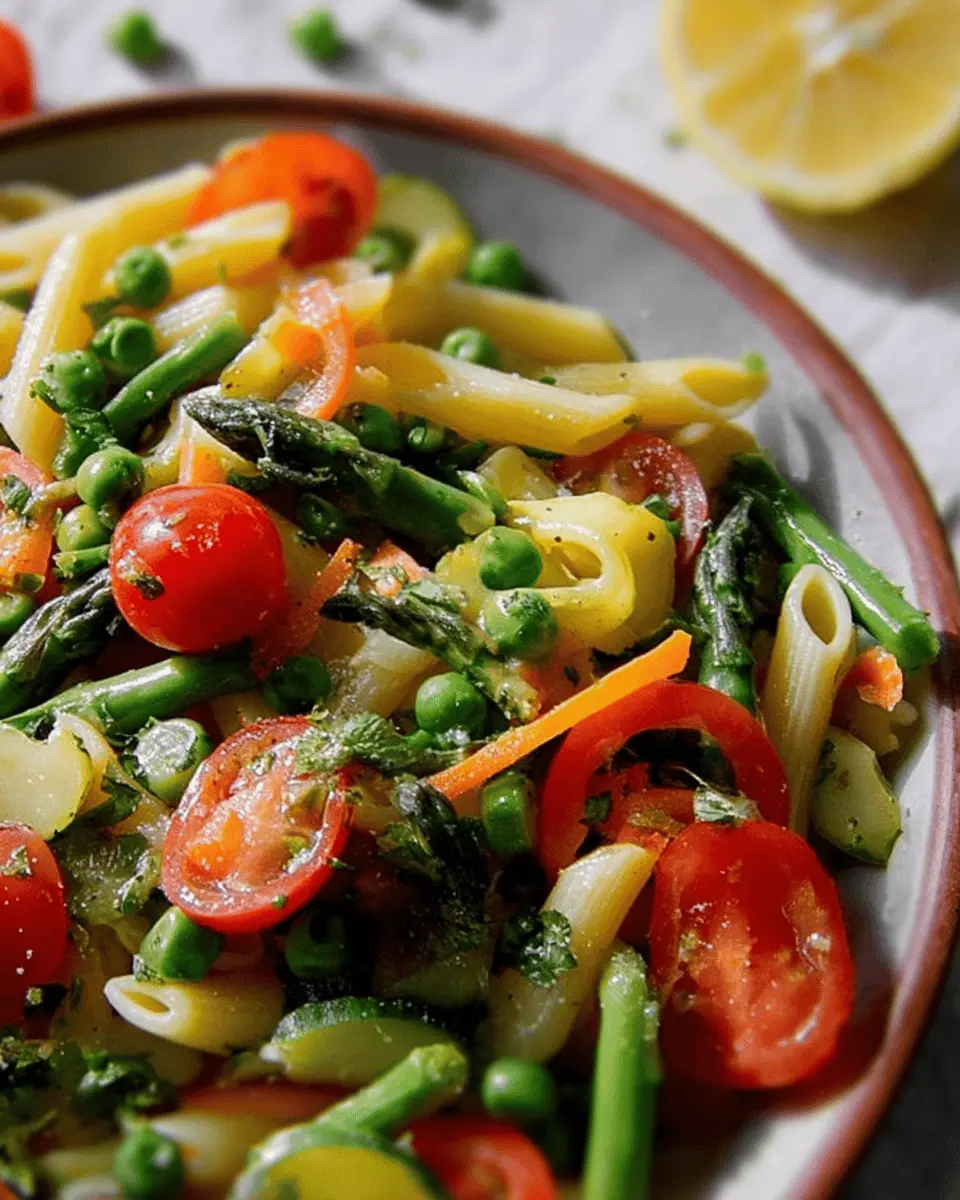
Ingredients for Pasta Primavera
Creating a vibrant pasta primavera is all about choosing the right ingredients. Here’s a breakdown to help you whip up this delightful dish with ease.
Key ingredients you'll need
To make a delicious pasta primavera, you’ll want to gather the following essentials:
- 16 oz penne pasta: This shape holds onto the sauce beautifully.
- Vegetables: A colorful mix including asparagus, yellow bell pepper, broccoli, zucchini, peas, and grape tomatoes.
- Aromatics: Minced shallots and garlic add depth to the flavor.
- Creamy Elements: Heavy cream and unsalted butter create the rich sauce, while lemon juice and zest lend a refreshing brightness.
- Herbs and Cheese: Fresh basil and Parmesan cheese enhance the overall taste, while optional red pepper flakes add a gentle kick.
Optional ingredient substitutions
Feel free to adapt the recipe to your liking! If you don’t have penne pasta on hand, any favorite pasta shape will work. For the veggies, you can swap in mushrooms, yellow squash, or even spinach based on availability. Want more protein? Consider adding chicken, shrimp, or even chickpeas for a filling meal. The versatility makes pasta primavera a fantastic dish that can suit any occasion!
For more tips on ingredient substitutions, check out this culinary guide.
Step-by-step Preparation for Pasta Primavera
Creating a delicious Pasta Primavera dish is not only simple but also an enjoyable cooking experience! Here’s a step-by-step preparation guide that makes the process as smooth as possible.
Boil the pasta
Begin by bringing a large pot of water to a roaring boil. Don’t be shy—add a generous amount of salt; it’ll help to flavor the pasta. Once it's bubbling, toss in 16 oz of penne pasta (or your favorite shape) and cook according to the package instructions—about 11 minutes should do the trick. Make sure to stir occasionally to prevent the pasta from sticking. Once cooked to al dente perfection, drain the pasta thoroughly, then return it to the pot to keep warm while you prepare the rest of your ingredients.
Sauté the fresh vegetables
Next, grab a large skillet and heat 1 tablespoon of olive oil over medium-high heat. It’s time to bring those vibrant vegetables to life! Start by adding 8 oz of asparagus, 1 yellow bell pepper, and 2 cups of small broccoli florets. Sauté for about 2 to 3 minutes, stirring occasionally until they start to soften. Then, introduce 1 chopped zucchini and continue cooking for another minute or two. Remember, you want the veggies to be tender yet still crisp. Season with salt and black pepper to taste before transferring them to a plate.
Create the lemon cream sauce
With the vegetables resting, return the skillet to the heat and melt 2 tablespoons of unsalted butter over medium heat. Once melted, add 1 minced shallot and 4 minced garlic cloves, cooking until fragrant, about 2 minutes. Then stir in the zest of 1 lemon and 1 cup of vegetable broth, letting it simmer until reduced by half—around 4 to 5 minutes. For that creamy touch, pour in ½ cup of heavy cream and mix in 2 tablespoons of lemon juice. Allow the sauce to bubble gently and thicken, making it irresistibly rich.
Combine pasta, vegetables, and sauce
Now for the fun part! Stir 1 cup of frozen peas into the pot with your pasta, then gently fold in the sautéed vegetables and pour that luscious lemon cream sauce over everything. Remember to stir well, ensuring that every piece of pasta and vegetable is coated in that amazing sauce. Finally, mix in ½ cup of shredded Parmesan cheese and the remaining 1 tablespoon of fresh lemon juice, adjusting the seasoning with salt and black pepper as needed.
Garnish and serve
Pour your Pasta Primavera into a large serving dish and let the colors of your vegetables shine. Sprinkle with ¼ cup of chopped basil, 2 tablespoons of Italian parsley, and some extra Parmesan for that finishing touch. A dash of crushed red pepper flakes can add a hint of spice if your palate is ready for it! Serve warm and enjoy the delightful burst of flavors—your friends and family will love this!
For even more easy and enjoyable recipes, check out tips on eating more vegetables and recipe variations!
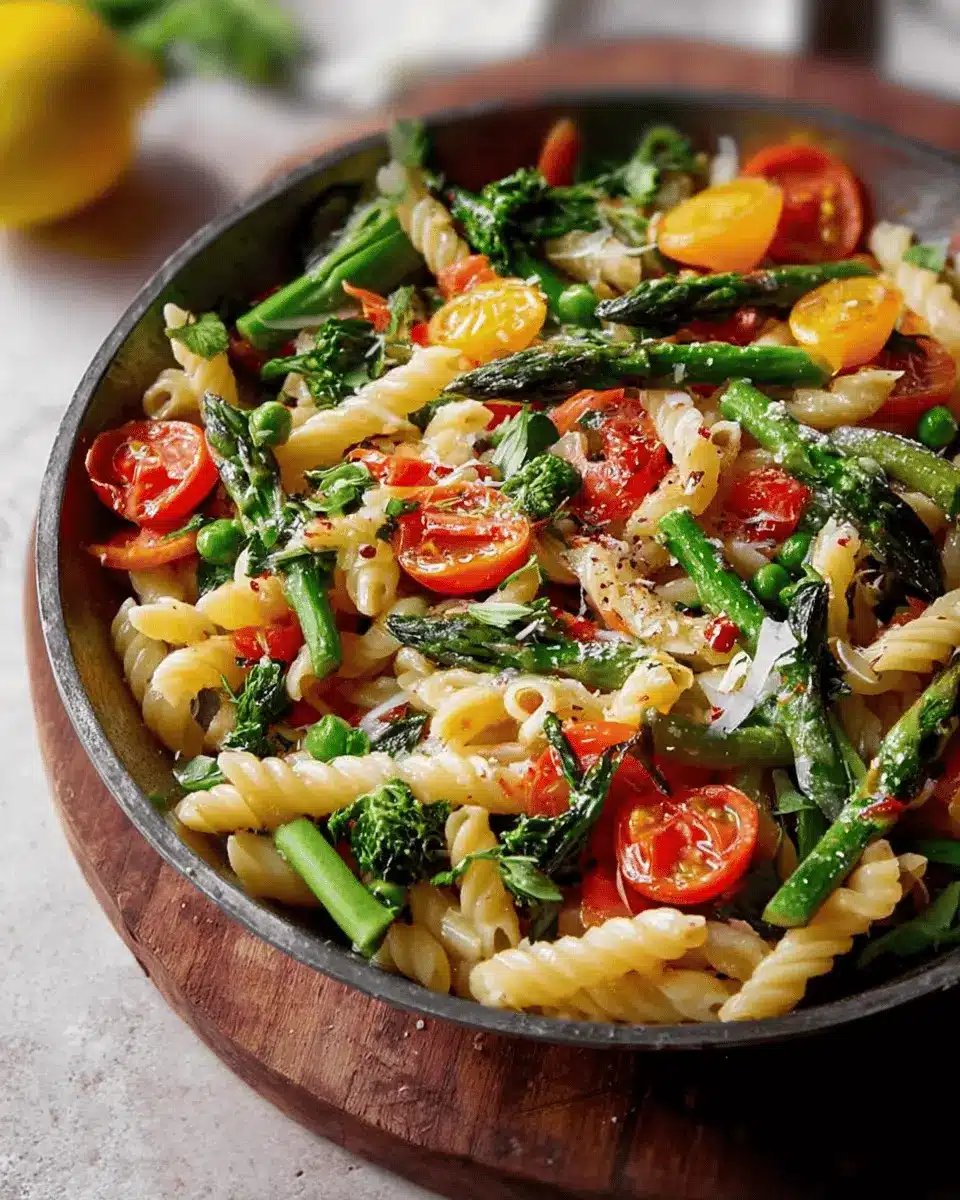
Variations on Pasta Primavera
Seasonal Vegetable Swaps
One of the best aspects of pasta primavera is its versatility! Adjust your vegetable choices based on the season—spring might call for asparagus and peas, while fall could inspire the inclusion of butternut squash and kale. Other delicious options include mushrooms, artichoke hearts, and spinach, adding flavor and color to your dish. The mix-and-match approach not only keeps things exciting but also allows you to utilize what’s fresh and in season.
Adding Proteins like Chicken or Tofu
If you’re looking to boost the nutrition of your pasta primavera, consider adding proteins! Chicken, grilled to perfection, provides a satisfying element, while tofu offers a great vegetarian alternative. Simply sauté your chosen protein in the same skillet before adding the vegetables. Want more inspiration? Check out sources like The Spruce Eats for more ideas on incorporating protein into your meals! Including these ingredients can transform your pasta into a heartier dish, perfect for hungry professionals on the go.
Cooking Tips and Notes for Pasta Primavera
Make-Ahead Tips and Storage Advice
To save time during busy weekdays, consider prepping your Pasta Primavera ingredients in advance. Chop your vegetables and store them in airtight containers in the fridge for up to 3 days. You can also cook the pasta a day ahead—just toss it with a bit of olive oil to prevent sticking. To store leftovers, place them in an airtight container; they’ll keep well in the fridge for about 5 days. Reheat gently on the stove, adding a splash of vegetable broth for moisture.
Tips for Getting the Sauce Just Right
Achieving the perfect sauce for your Pasta Primavera is simple! Start by ensuring to sauté your shallots and garlic until fragrant—this gives a robust flavor base. When adding the vegetable broth, let it reduce by half for a richer taste. Don't forget to incorporate the heavy cream and lemon juice gradually, tasting along the way. Adjust the seasoning with salt and pepper, and if you love a bit of heat, a dash of crushed red pepper flakes enhances the final dish beautifully!
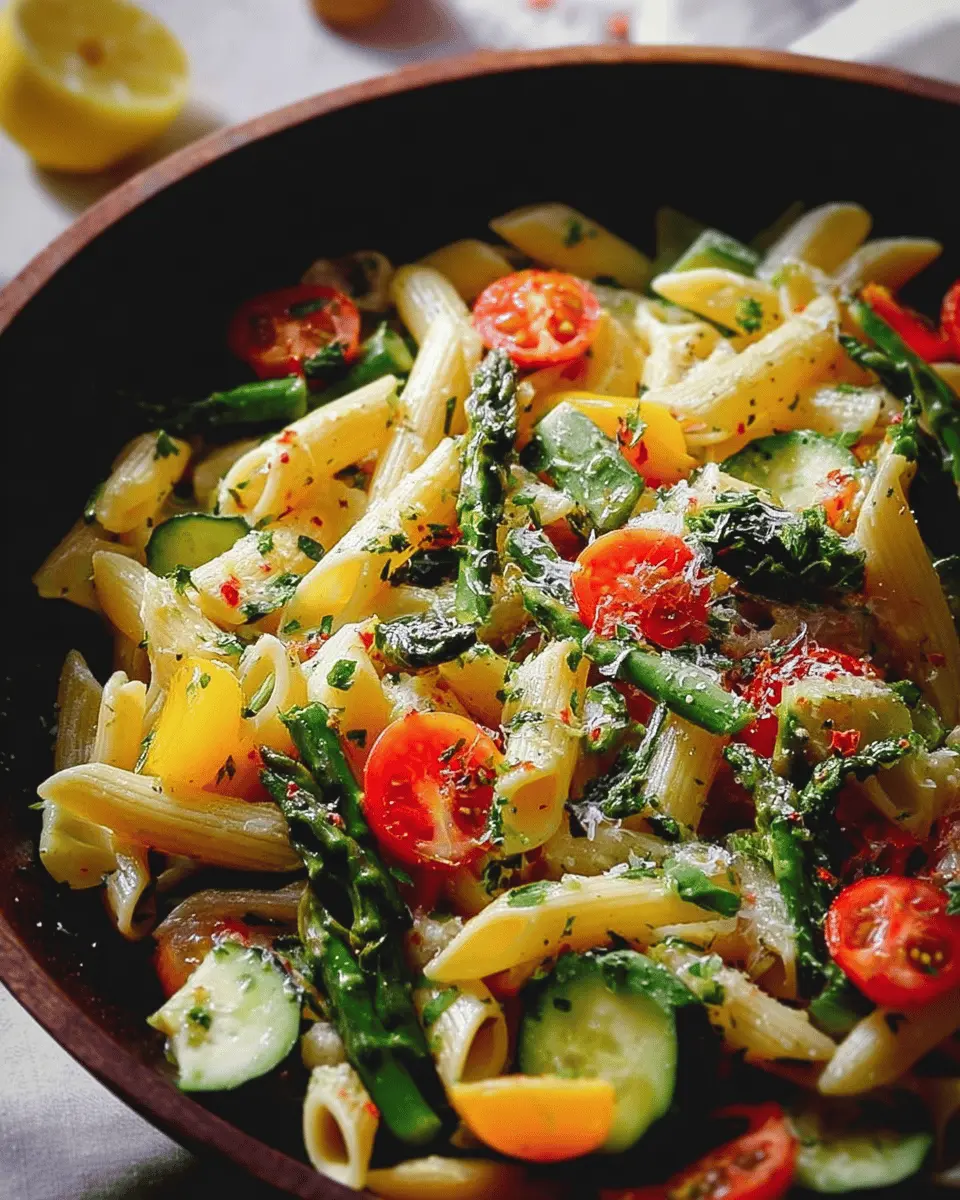
Serving Suggestions for Pasta Primavera
Pairing with Sides or Salads
Elevate your Pasta Primavera experience by pairing it with a light, refreshing salad or side dish. Consider a simple arugula salad topped with cherry tomatoes and a zesty lemon vinaigrette. If you’re in the mood for something warm, garlic bread or grilled veggies complement the pasta perfectly—a delicious balance of flavors!
Creative Serving Ideas
For a memorable presentation, try serving Pasta Primavera in individual bowls topped with extra Parmesan cheese and freshly chopped herbs. You can also make a delightful pasta bar! Set out a variety of toppings like olives, pine nuts, and fresh herbs to let your guests create their own unique combinations. This not only sparks creativity but also adds a fun, interactive element to your meal!
For more salad inspiration, check out resources from EatingWell or BBC Good Food.
Time Breakdown for Pasta Primavera
Preparation time
This delightful Pasta Primavera takes about 15 minutes to prepare. This is your time to chop the veggies and gather all your ingredients, making the cooking process a breeze.
Cooking time
You'll spend around 20 minutes cooking, with your pasta and the vibrant veggies coming together beautifully for a satisfying meal.
Total time
In just 35 minutes, you’ll have a colorful, delicious Pasta Primavera ready for dinner, perfect for a busy weeknight or a cozy weekend gathering. Want more tips on timing? Check out this article for insights on meal planning!
Nutritional Facts for Pasta Primavera
Calories per serving
Each serving of pasta primavera contains approximately 375 calories, making it a satisfying yet manageable dish for any meal.
Key nutritional highlights
This vibrant dish is packed with essential nutrients:
- Carbohydrates: 52g, providing energy for your busy day.
- Protein: 13g, supporting muscle health and recovery.
- Fiber: 4g, aiding in digestion and keeping you full.
- Vitamins: High in Vitamin A (1265 IU) and Vitamin C (67.7 mg), promoting overall wellness.
With the combination of colorful vegetables and wholesome ingredients, pasta primavera is a delicious way to eat healthily! For more in-depth nutrition information, check out The USDA FoodData Central.
FAQs about Pasta Primavera
Can I make pasta primavera without cream?
Absolutely! If you're looking to lighten up your pasta primavera, simply replace the heavy cream with alternatives like coconut milk, almond milk, or even a splash of vegetable broth for a lighter feel. You can also use a blend of cream cheese and vegetable broth to achieve a creamy texture without dairy.
What vegetables are best for pasta primavera?
The beauty of pasta primavera lies in its versatility! While asparagus, bell peppers, and zucchini are classic choices, feel free to mix in other favorites like spinach, cherry tomatoes, or mushrooms. Seasonal vegetables work wonderfully, too! You can check out more about vegetable pairings on reputable sites like EatingWell to get inspired.
How can I make pasta primavera gluten-free?
Making pasta primavera gluten-free is straightforward! All you need is to swap out regular pasta for your favorite gluten-free pasta brand. There are plenty of options available, from brown rice pasta to zucchini noodles, that can match the dish's flavor and texture perfectly. Don't hesitate to experiment and find your perfect blend!
Conclusion on Pasta Primavera
Making Pasta Primavera at home is not just rewarding; it’s a delightful experience that brings fresh flavors and vibrant colors to your plate. With simple, wholesome ingredients, you can create a dish that’s both nourishing and satisfying. Plus, customizing it to fit your taste is where the fun begins!
Why Homemade Pasta Primavera is Worth It
Creating Pasta Primavera from scratch allows you to control the quality of ingredients while embracing creativity in the kitchen. Here’s why you should consider whipping this up at home:
- Fresh Ingredients: Using seasonal vegetables enhances the dish's flavor and nutrition.
- Easy Customization: Switch up veggies or add protein to fit dietary preferences.
- Healthier Choices: You can reduce fat, sodium, and calories by controlling the ingredients and avoid the preservatives found in some restaurant versions.
- Save Money: Homemade meals are often more economical, especially when serving multiple people.
Want to dive deeper into the science of fresh produce benefits? Check out this article on the advantages of seasonal eating. With Pasta Primavera, you get a nourishing meal that brings warmth and comfort, whatever the season!
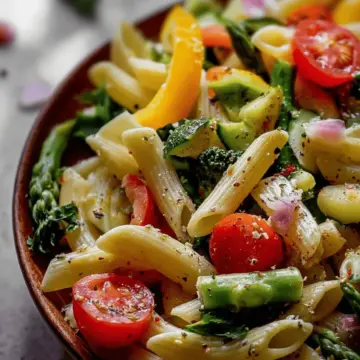
Pasta Primavera: The Best Colorful Veggie Delight You'll Love
Equipment
- large pot
- large skillet
Ingredients
Pasta and Vegetables
- 16 oz penne pasta
- 1 tablespoon olive oil
- 8 oz asparagus cut into 1 ½-inch pieces
- 1 each yellow bell pepper cut into 1 ½-inch pieces
- 2 cups small broccoli florets
- 1 small zucchini chopped
- Salt and black pepper to taste
- 2 tablespoons unsalted butter
- 1 each shallot minced
- 4 cloves garlic minced
- 1 each lemon zest of
- Dash crushed red pepper flakes
- 1 cup vegetable broth
- ½ cup heavy cream
- 3 tablespoons lemon juice divided
- 1 cup frozen peas
- ½ cup shredded Parmesan cheese
- 1 ½ cups halved grape tomatoes
- ¼ cup chopped basil
- 2 tablespoons Italian parsley for garnish
- Extra parmesan cheese for garnish
- Crushed red pepper flakes for garnish
Instructions
Cooking Instructions
- Bring a large pot of water to a boil. Add salt and pasta to boiling water. Cook for 11 minutes, stirring occasionally. Drain well. Pour the pasta back into the pot.
- Meanwhile, in a large skillet, heat the olive oil over medium high heat. Add the asparagus, peppers, and broccoli. Sauté for 2 to 3 minutes, stirring occasionally. Add in the zucchini and cook for 1 to 2 minutes or until vegetables are tender but still crisp. Season vegetables with salt and pepper, to taste. Transfer the vegetables to a large plate or bowl.
- Place the skillet back on the stove. Melt the butter over medium heat. Add the shallot and garlic and cook for 2 minutes. Stir in the lemon zest and vegetable broth. Simmer until the broth reduces by half, about 4 to 5 minutes. Stir in the heavy cream and 2 tablespoons of lemon juice.
- Stir the peas into the pot with the pasta. Stir in the cooked vegetables. Pour the lemon cream sauce over the pasta and vegetables and stir until well combined. Stir in the Parmesan cheese and remaining tablespoon of fresh lemon juice. Gently stir in the tomatoes and basil. Season with salt and black pepper, to taste.
- Pour the pasta primavera into a large serving bowl or dish. Garnish with parsley, extra Parmesan cheese, and crushed red pepper flakes. Serve warm.




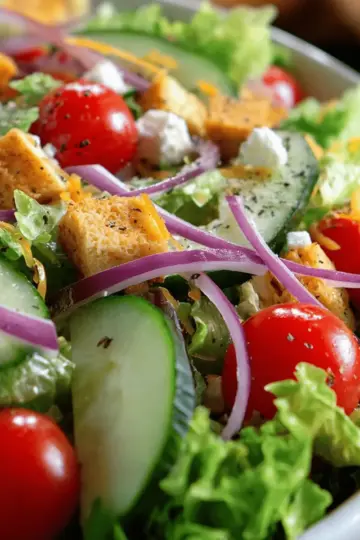
Leave a Reply